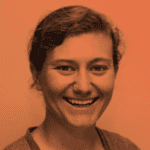
How Vimeo’s Community Helps Them Create Better Products
Community management helps to create better products. Get expert advice on how to gather product feedback and benefit from surveys.
We recently caught up with Alexandra Dao, Senior Manager, Research and Customer Insights for Vimeo. Alexandra spoke about how she works with current Vimeo users to do usability testing on new products. Although she doesn’t have a community manager title any more, Alexandra’s career began in community management – and she’s taken those lessons with her.
She’s also part of the We Support NYC team, who curates a weekly community management and support newsletter (one of our favorites!).
Higher Logic: Tell us more about your background in community management and product usability testing.
Alexandra Dao: I started working in community management in 2008, right after college. That was around the time when using social media as a brand was starting to happen. It was early on the social media side of things and my role was primarily focused on marketing and communications. From there, I worked in more traditional community management roles.
Before working at Vimeo, I worked at two different startups where I was a community management department of one. I worked on gathering feedback on current products and getting early feedback about new features as well writing newsletters and maintaining the company’s blogs and social media accounts. For example, at HopStop we asked our users what cities we should launch next and relied heavily on their feedback to prioritize new cities.
Vimeo is the biggest company I’ve worked at to date and when I joined, it was the first time I was part of a team. I focused on support and eventually I was also handling our feature requests forum and finding opportunities to raise long-standing requests so they weren’t being forgotten.
The common thread in all my jobs has been making sure I can be the voice of the user internally.
HL: How do you gather product feedback from your Vimeo users?
AD: I was on Vimeo’s community team for four years, and last year I shifted to the Business Intelligence team to work in a research role.
User research has very much become part of our product development process. Generally, we’ll survey our members to get early feedback on what features we should be prioritizing. Then we’ll do usability testing once we’re in the prototype phase so we can validate or invalidate our own assumptions.
HL: What’s your process for adding new features?
AD: Our community team tracks email requests very closely. They maintain a spreadsheet that they share internally that shows the top feature requests and indicates whether or not they’re planned in our roadmap.
Generally, the product team will prioritize feature requests based on how many people would ultimately use it. We’re building out some new functionality that we’re excited about but also looking at older products and asking ourselves how we can improve them.
HL: Are most product ideas internal or based on user suggestions?
AD: A lot of ideas come from the community. There are so many people who rely on us as part of their professional workflow, so of course they have a lot of suggestions and feedback. Surveys help us determine how many users want new features, and if we want to go deeper we’ll also conduct user interviews to get a better understanding of the use cases and expectations for those features.
Writing and analyzing surveys is not something I did as a Community Manager, so I’m learning a lot as I go. I find it really fun because I come from a sociology background and it’s exciting to get the results back and start analyzing the data.
HL: Do you think community managers would benefit from incorporating more surveys?
AD: It’s so valuable to have another way of gathering information from a large group of people. And sometimes, depending on who your internal stakeholders are, they may be more swayed by numbers than qualitative feedback, so it’s good to have another tool at your disposal. If you think a survey would lend more support to what you’re trying to do then it’s absolutely worth considering.
One thing I’ve learned is that the scope of a community manager’s role evolves as a company grows. Sometimes things get siloed off into other departments – if you’re doing surveys regarding your community, that should be a cross-department effort to make sure you aren’t overlapping with other departments and to make sure you’re asking the right questions.
HL: How do you connect community and product?
AD: Coming from a community perspective, I think it’s important to listen to your users, to be proactive, and to bring them in early on in the process. Doing so allows us to fix small things before we launch them. Or, if we can’t address them before launching something new, we know what to prioritize in the next iteration.
The downside to involving users early on is managing expectations. The moment you ask for someone’s feedback, they’re more invested in the outcome. There are some things we get feedback on that’s valid, but we might not be able to change it before we launch, and that can disappoint people who suggested those changes.
Any time you have a public forum for feature requests you run the risk of a pile-on effect, which can lead people to think more votes mean that change will happen. So, it’s important to set guidelines and manage expectations.
HL: How do you share insights from usability testing with the product team?
AD: Our product team is very involved in usability testing and user interviews. They’ll sit in on sessions when they can. Which means they can jump in with questions if something comes up during the session and they want to learn more. The nice thing about having them involved is that they’re hearing the insights as they’re happening so the final report isn’t a big reveal. Often, we’ll make changes after the first few sessions if there are common areas of confusion so really, we’re essentially doing rapid prototyping with our community members and building new products and features with their direct input.
HL: Do users ever surprise you?
AD: I’m continually surprised by how willing people are to help by giving us their time and feedback and ultimately, how much they care about the final product. As a user researcher, I’m so grateful that people are willing to answer surveys and participate in usability and beta testing. All of that helps us so much! Sometimes I’m surprised by how closely our users are paying attention to everything we’re doing. I’ve had usability testers mention a few early staff members by name and trace our company’s evolution and their experiences with Vimeo. It’s pretty incredible.
HL: Did Vimeo start with community and usability testing in mind?
AD: We haven’t always had a process for usability testing, but when I was on the Community team I saw a clear need for it before launching new products and offered to run the testing since it’s something I had done at previous companies. Usability testing is a way for us to feel more comfortable launching products. I feel we’ve had smoother launches since we made it part of our process, which is a win for everyone involved.
HL: What are you excited about these days, community-related or otherwise?
AD: Lately, I’ve been thinking a lot about inclusion and diversity in tech. We’ve tried to highlight resources we think are helpful in We Support, especially since we know we have a lot of people managers who subscribe to the newsletter. Managing is hard, so we want to make sure people have a better understanding of people’s experiences in the workplace and how identity can affect that.
HL: Have you connected your passion for diversity and inclusion with your work?
AD: I helped found an employee community group for people of color at Vimeo. It can be difficult to balance your full-time job with extracurricular activities but thankfully we have a great team of organizers and we’re mindful of maintaining a balance. Something I’ve been thinking a lot about is how to get more people involved, even if they are not part of marginalized communities. Ultimately, inequality affects everyone so everyone should be working towards a solution, and it’s just as much about employee retention as it is getting more diverse candidates in the pipeline. It’s a challenge and to my knowledge, no company has gotten it completely right but I’m happy to see that it’s being widely discussed and people are paying attention.


